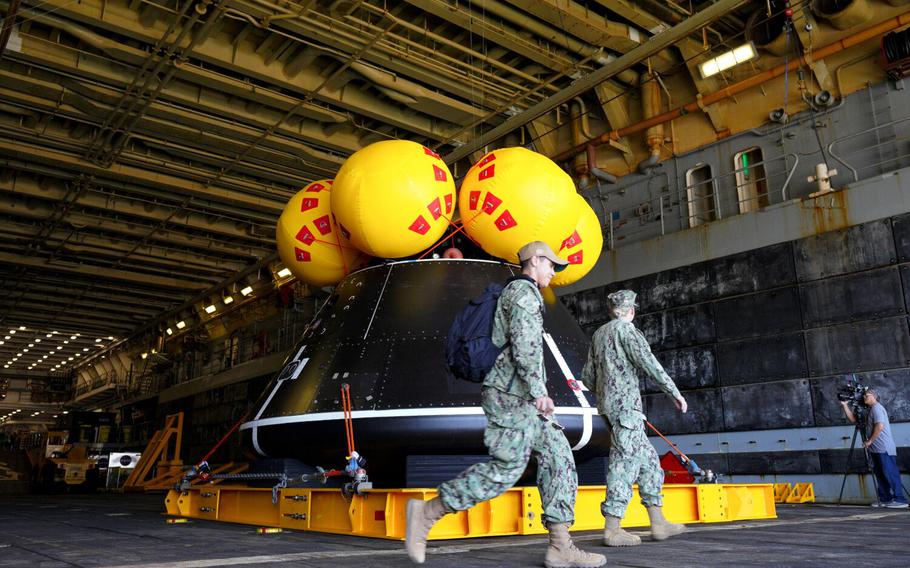
Officials from NASA and the U.S. Navy spoke with members of the news media about NASA’s first recovery test for Artemis II, on board the transport dock ship USS John P. Murtha (LPD 26) at Naval Base San Diego, Wednesday, Aug. 2, 2023. (Nelvin C. Cepeda, The San Diego Union-Tribune/TNS)
(Tribune News Service) — NASA's quest to send astronauts to the moon in a tiny spacecraft that later returns to Earth and parachutes into the Pacific Ocean has gotten a big lift from the Navy, which safely recovered a capsule and four stand-in crew members numerous times last week during drills off San Diego.
The exercises represented a critical dress rehearsal for Artemis II, a mission in which four astronauts will fly to the moon and back late next year. NASA will later attempt to place astronauts on the lunar surface in a possible step toward the human exploration of Mars.
A mock version of the new Artemis' Orion spacecraft was repeatedly placed in the ocean last week by the San Diego-based USS John P. Murtha, a cavernous transport dock ship. The capsule was manned by four officers and sailors from Naval Air Station North Island.
The volunteers were stand-ins for the real astronauts. They remained inside the capsule until they could be safely extracted and transferred back to the ship by helicopter. Orion was guided back by boat crews.
The joint drills by the Navy, NASA and Air Force occurred during the day and at night near Santa Catalina Island, and each was safely completed within an allotted two-hour time period, officials said.
"I would say that everything that we planned went as planned, but we're going to take a lot of lessons learned, specifically how we communicate with each other," Liliana Villarreal, NASA's recovery director, told reporters Wednesday at Naval Base San Diego.
The Navy was building on an earlier success. In December, the USS Portland, another San Diego-based transport dock ship, recovered a real Orion capsule after it splashed down in the Pacific, about 35 miles southwest of San Diego, following a 25-day trip around the moon.
Last week's drills were more complicated because people were placed in the capsule after it was situated in the water.
NASA said Wednesday that the four astronauts assigned to the Artemis II mission — Christina Hammock Koch, Reid Wiseman, Victor Glover and Jeremy Hansen — will travel to San Diego next spring and participate in splashdown recovery drills with the Navy.
If all goes as scheduled, those astronauts will fly to the moon and back in late fall and splash down not far from San Diego, where they'll be recovered by a local warship.
This type of landing isn't new or unique. It was used by astronauts during the Mercury, Gemini and Apollo programs. But it can be dangerous. In July 1961, Mercury astronaut Gus Grissom's Liberty Bell 7 capsule sank after splashdown and nearly drowned the astronaut.
The Artemis program deeply appeals to Capt. Douglas M. Langenberg, the commanding officer of the Murtha.
"Returning to the moon … it's awe-inspiring to be part of that," he said Wednesday.
©2023 The San Diego Union-Tribune.
Visit sandiegouniontribune.com.
Distributed by Tribune Content Agency, LLC.